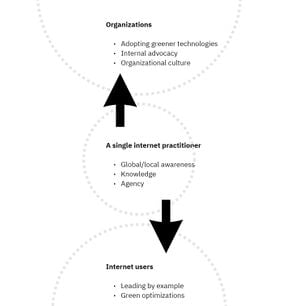
The middle-out approach is based on the premise that mid-level practitioners with technical expertise have the unique ability to influence many actors within an organizational system at different levels.[1] In the case of Internet practitioners, access to both information and expertise opens the door to obtaining power even outside of more recognizable sources such as hierarchy, reward or coercion.[2]
In other words, your knowledge and expertise grant you an actionable influence in organizations, and it increases the importance of developing a better carbon literacy. This is especially relevant for the Internet due to its changing landscape. According to a report by The Shift Project, the rapid growth of ICT will lead to an increase of its energy usage.[3] This means that there is a pressing need for practitioners like you to develop a broader perspective of their environmental impacts.
The narrative divide[edit | edit source]
Exploring the environmental effects of digital technologies is a difficult task due to both elements (the digital and the environment) living far apart in our heads. For example, we tend to think of the digital in terms of the computer in front of us. Perhaps we can associate it to our computers and some other elements, but for the most part, the elements that comprise the digital are hard to grasp. For example, Murlow et al. (2021) did a comprehensive literature review on digital technologies and found that most environmental assessments of digital technologies tend to overlook many of the subsystems that comprise digital technologies (all their physical and non-physical components) and dynamics (how they affect society).[4]
Both of these elements are important to understand the complex system that plays a role in delivering data to our screen. However, Gould (2016) poses that we are biased to see either the mechanistic and the humanistic aspects of technologies but not both at the same time, and this is not enough to help us frame environmental narratives correctly.[5]
As we explore both of these areas, we will get a more complete view of how our organizations affect the environment, and will help us think of the areas where we can create impact.
Assess your organization's impact[edit | edit source]
Start the evaluation by going to the following sections.
References[edit | edit source]
- ↑ Parag, Y., & Janda, K. B. (2014). More than filler: Middle actors and socio-technical change in the energy system from the "middle-out." Energy Research & Social Science, 3, 102–112. https://doi.org/10.1016/j.erss.2014.07.011
- ↑ Author removed at request of original Publisher. (2017). The Power to Influence. In: Organizational Behavior. University of Minnesota. https://open.lib.umn.edu/organizationalbehavior/chapter/13-3-the-power-to-influence/
- ↑ Lean ICT: Towards Digital Sobriety. (2019). The Shift Project. https://theshiftproject.org/en/article/lean-ict-our-new-report/
- ↑ Mulrow, J., Gali, M., & Grubert, E. (2021). The cyber-consciousness of environmental assessment: How environmental assessments evaluate the impacts of smart, connected, and digital technology. Environmental Research Letters, 17(1), 013001. https://doi.org/10.1088/1748-9326/ac413b
- ↑ Gould, A. S. (2016). Restor(y)ing the Ground: Digital Environmental Media Studies. Networking Knowledge: Journal of the MeCCSA Postgraduate Network, 9(5), Article 5. https://doi.org/10.31165/nk.2016.95.455